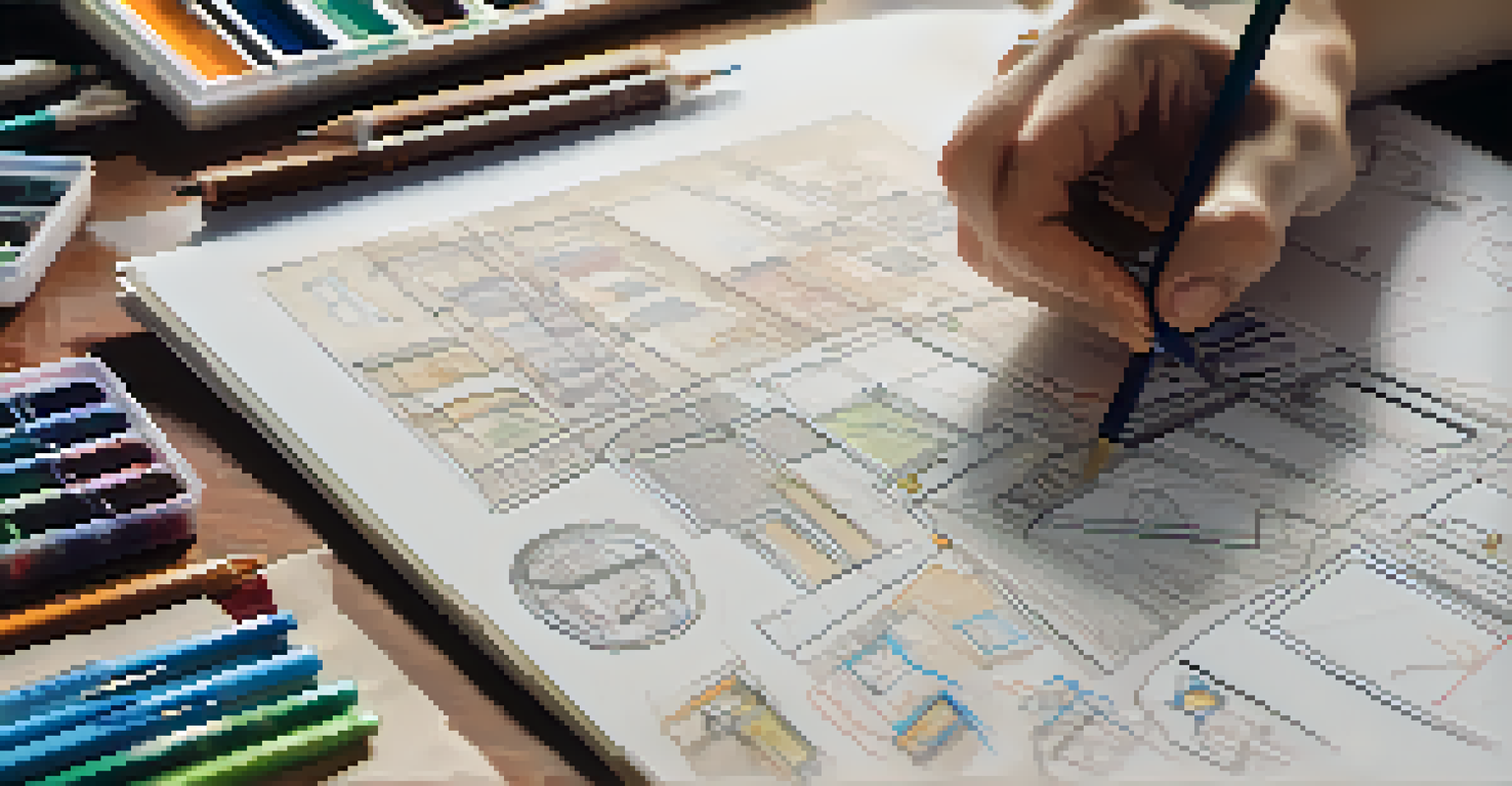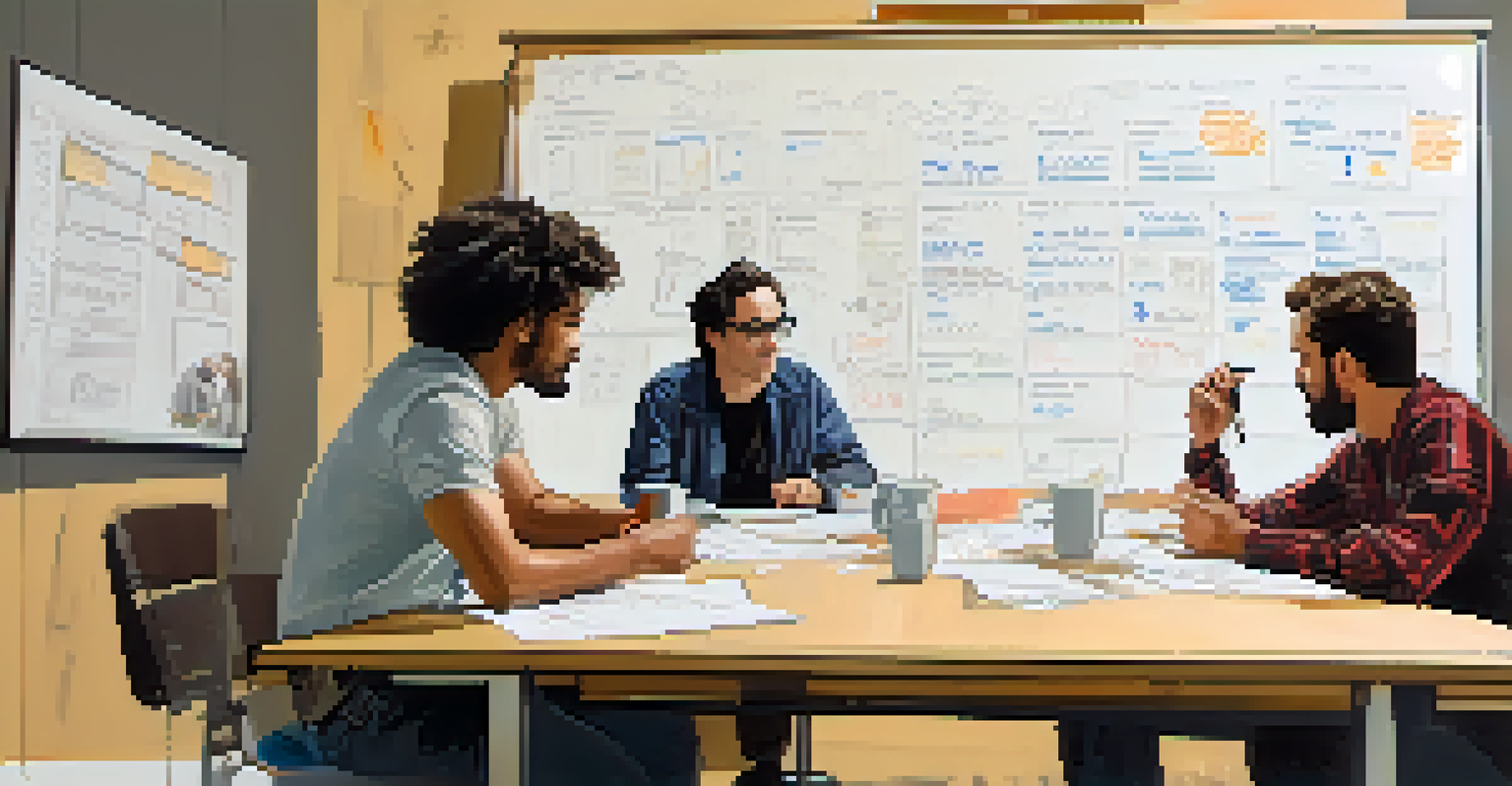How Storyboarding Improves Visual Planning in Film Projects

Understanding the Basics of Storyboarding
Storyboarding is a visual outline used in film production. It involves sketching scenes in sequential order to depict how the story unfolds. This technique helps filmmakers visualize their narrative before the actual shooting begins, ensuring clarity in storytelling.
A storyboard is the blueprint for the film. It’s how you communicate your vision with the crew and get everyone on the same page.
Think of storyboarding as a roadmap for your film; it highlights the key scenes and transitions, guiding you from the beginning to the end. Each frame serves as a snapshot of a moment, allowing creators to focus on composition, camera angles, and overall pacing. This preparatory step ultimately saves time during filming.
In a way, storyboarding functions like a comic strip, where each panel represents a different part of the story. This method not only aids in visualizing the narrative but also fosters collaboration among the crew, providing everyone with a clear understanding of the director's vision.
Enhancing Visual Communication with Storyboards
Visual communication is crucial in filmmaking, and storyboards are a powerful tool in achieving it. By translating scripts into visuals, they help convey the story to the entire team, including cinematographers, production designers, and actors. Everyone can see how their role fits into the bigger picture.

Imagine trying to explain a complex scene without visuals; it can lead to misunderstandings and misinterpretations. Storyboards eliminate that ambiguity by providing a clear visual reference. This clarity helps maintain the film's overall vision and ensures that every team member is on the same page.
Storyboarding as a Visual Roadmap
Storyboarding serves as a visual outline that helps filmmakers plan scenes sequentially, ensuring clarity in storytelling.
Moreover, storyboards serve as a reference point during production, allowing for adjustments as needed. If a scene isn’t working as planned, the storyboard provides a framework to discuss alternative approaches without losing sight of the original intent.
Streamlining the Filming Process Through Storyboarding
Time is of the essence in film production, and storyboarding significantly streamlines the filming process. By planning scenes visually beforehand, filmmakers can identify potential challenges early on. This foresight minimizes delays during shooting, making the whole process more efficient.
Storyboarding is a way to take the chaos of filmmaking and turn it into a clear path to the final product.
For instance, if a scene requires multiple camera angles, storyboarding allows the crew to plan those shots in advance. This preparation helps avoid unnecessary retakes and wasted time on set, which can be both costly and frustrating. It’s like having a rehearsal before the actual performance.
Additionally, a well-structured storyboard can help allocate resources effectively. Filmmakers can determine which scenes require more time or special equipment, allowing for better budgeting and scheduling throughout the production.
Fostering Creativity Through Structured Planning
While storyboarding provides structure, it also fosters creativity. By visualizing scenes, filmmakers can explore different ideas and artistic choices before committing to them. This exploration encourages experimentation, allowing creators to think outside the box.
For example, a storyboard can inspire innovative camera movements or unique visual storytelling techniques. As filmmakers sketch out their ideas, they might discover fresh perspectives that enhance the narrative. This creative freedom is vital in a medium where visual storytelling reigns supreme.
Enhancing Collaboration Through Visuals
Storyboards provide a shared visual reference that fosters teamwork and aligns the efforts of the entire production crew.
Moreover, storyboarding can serve as a collaborative platform, inviting input from various team members. This collaboration can spark new ideas and lead to a richer, more engaging film that incorporates diverse creative insights.
Improving Audience Engagement with Visual Planning
Engaging the audience is a primary goal of any film, and storyboarding plays a key role in achieving this. By carefully planning each scene, filmmakers can create a visual rhythm that captivates viewers from start to finish. A well-paced film keeps audiences invested in the story.
Consider how a storyboard allows filmmakers to control the emotional flow of a scene. By mapping out moments of tension, joy, or sorrow, creators can strategically place high-impact visuals that resonate with viewers. This thoughtful approach to visual storytelling enhances the overall audience experience.
Additionally, storyboards help maintain consistency in visual style and tone throughout the film. This consistency reinforces the film's message and emotional undercurrents, making it more likely to leave a lasting impression on its audience.
Facilitating Better Collaboration Among the Crew
Collaboration is crucial in filmmaking, and storyboarding enhances this aspect significantly. By providing a shared visual reference, everyone involved in the project can align their efforts towards a common goal. This shared understanding fosters teamwork, which is essential for a successful production.
For instance, when directors, cinematographers, and production designers can refer to the same storyboard, it creates a unified vision. Each department knows what to expect and can contribute their expertise effectively. This collaboration ensures that the final product reflects the collective effort of the entire team.
Revising Storyboards for Adaptability
Regularly updating storyboards allows filmmakers to adapt to unforeseen challenges while maintaining their original vision.
Moreover, storyboards can facilitate discussions and brainstorming sessions, allowing team members to offer feedback and suggestions. This collaborative atmosphere encourages creativity and innovation, leading to a more polished and cohesive film.
The Importance of Revising Storyboards
Revising storyboards is an essential part of the filmmaking process. As production progresses, unforeseen challenges often arise that may necessitate changes to the original plan. Regularly updating storyboards allows filmmakers to adapt to these changes while still maintaining their vision.
For example, if a location becomes unavailable, the storyboard can be adjusted to reflect new filming locations or angles. This flexibility ensures that filmmakers can respond to real-world constraints without losing sight of their narrative goals. It's like recalibrating your GPS when you hit a detour.

Additionally, revisiting storyboards can spark new ideas or approaches that enhance the overall film. Each revision provides an opportunity to refine the narrative and visuals, ultimately leading to a stronger final product that resonates with audiences.